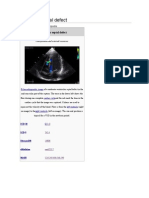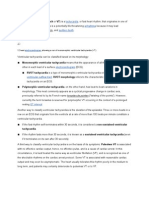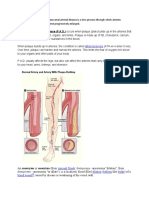Dextrocardia
Dextrocardia
Uploaded by
TemptationCopyright:
Available Formats
Dextrocardia
Dextrocardia
Uploaded by
TemptationOriginal Description:
Copyright
Available Formats
Share this document
Did you find this document useful?
Is this content inappropriate?
Copyright:
Available Formats
Dextrocardia
Dextrocardia
Uploaded by
TemptationCopyright:
Available Formats
Dextrocardia is a congenital defect in which the heart is situated on the right side of the body.
There are two main types of dextrocardia:dextrocardia of embryonic arrest (also known as isolated [citation needed] dextrocardia ) and dextrocardia situs inversus. Dextrocardia situs inversus is further divided.
Contents
[hide]
1 Dextrocardia of embryonic arrest 2 Dextrocardia situs inversus 3 Diagnosis 4 Technical dextrocardia 5 Management 6 References 7 External links
Dextrocardia of embryonic arrest[edit]
In this form of dextrocardia, the heart is simply placed farther right in the thorax than is normal. It is commonly associated with severe defects of the heart and related abnormalities including pulmonary [1] hypoplasia.
Dextrocardia situs inversus[edit]
Dextrocardia situs inversus refers to the heart being a mirror image situated on the right side. For all visceral organs to be mirrored, the correct term isdextrocardia situs inversus totalis. Dextrocardia is believed to occur in approximately 1 in 12,000 people.
[2]
Although statistically people with dextrocardia situs inversus do not have any medical problems from the disorder, they may be prone to a number of bowel, esophageal, bronchial and cardiovascular disorders (such as double outlet right ventricle, endocardial cushion defect and pulmonary [3] stenosis). Certain cardiovascular and pulmonary disorders related to dextrocardia can be lifethreatening if left unchecked (see ref). Kartagener syndrome may also be present in patients with dextrocardia situs inversus but also [4] involves mirrored positioning of major internal organs and may include male infertility.
Diagnosis[edit]
Medical diagnosis of the two forms of congenital dextrocardia can be made by ECG
[1]
or imaging.
Technical dextrocardia[edit]
Technical dextrocardia refers to an ECG reading that has no basis in the patient's anatomy. This apparent presentation of dextrocardia is caused usually by the technician inadvertently swapping the limb leads on a 12 lead ECG. Usually this would show as an extreme axis deviation.
Management[edit]
ECG leads must be placed in reversed positions on a person with dextrocardia. In addition, when defibrillating someone with dextrocardia, the pads should be placed in reverse positions. [6] is, instead of upper right and lower left, pads should be placed upper left and lower right.
[5]
That
You might also like
- 2022 Stroke Lecture (Updated Guidelines)Document54 pages2022 Stroke Lecture (Updated Guidelines)Meccar Moniem H. ElinoNo ratings yet
- Leprosy Patient Record CardDocument2 pagesLeprosy Patient Record CardAdane Belay100% (3)
- Cardiac Electrophysiology 2 An Advanced Visual Guide For Nurses Techs and Fellows 2EDocument294 pagesCardiac Electrophysiology 2 An Advanced Visual Guide For Nurses Techs and Fellows 2ETemptation100% (5)
- Biventricular Non-Compaction Cardiomyopathy With Left Ventricular DysfunctionDocument4 pagesBiventricular Non-Compaction Cardiomyopathy With Left Ventricular DysfunctionIJAR JOURNALNo ratings yet
- Ventricular Septal DefectDocument18 pagesVentricular Septal DefectJessa Marie AgnesNo ratings yet
- Ventricular Septal DefectDocument4 pagesVentricular Septal Defectk.kathiravanNo ratings yet
- Dorv Medscape 12345600Document9 pagesDorv Medscape 12345600ayubahriNo ratings yet
- Cardiac ArrestDocument7 pagesCardiac ArrestDiana MuañaNo ratings yet
- DextrocardiaDocument10 pagesDextrocardiaJellie MendozaNo ratings yet
- Stroke - WikipediaDocument53 pagesStroke - Wikipediapaskalis.bhaskara.unggul.yudhaNo ratings yet
- 12 CardiologyDocument16 pages12 CardiologyIsa AdelaNo ratings yet
- Types of Stroke: Stroke - CVA Cerebral Vascular Accident Ischemic Cerebrovascular DiseaseDocument7 pagesTypes of Stroke: Stroke - CVA Cerebral Vascular Accident Ischemic Cerebrovascular DiseaseMarrylane GamisNo ratings yet
- A CNN and ResNet 50 Approach To Detect Cardiac Diseases Using ECG ImagesDocument13 pagesA CNN and ResNet 50 Approach To Detect Cardiac Diseases Using ECG ImagesIJRASETPublicationsNo ratings yet
- Giant Left Atrial Appendage Aneurysm and Right Ventricular Diverticulum: A Very Rare AssociationDocument4 pagesGiant Left Atrial Appendage Aneurysm and Right Ventricular Diverticulum: A Very Rare AssociationIJAR JOURNALNo ratings yet
- Situs Inversus Imaging - Practice Essentials, Radiography, Computed TomographyDocument9 pagesSitus Inversus Imaging - Practice Essentials, Radiography, Computed TomographyFadil DendiNo ratings yet
- Situs InversusDocument4 pagesSitus InversusVishal ParnerkarNo ratings yet
- Dextrocardia With Situs Inversus in An Adult Turkish 5797Document3 pagesDextrocardia With Situs Inversus in An Adult Turkish 5797Nazura Mohd NasirNo ratings yet
- Cardiac ArrestDocument8 pagesCardiac ArrestprashantghodkeNo ratings yet
- Aortic Dissection - Cardiovascular Disorders - Merck Manuals Professional EditionDocument11 pagesAortic Dissection - Cardiovascular Disorders - Merck Manuals Professional Editionjeffreyblair2022No ratings yet
- Introduction To MedicineDocument1 pageIntroduction To MedicineNurul AininaNo ratings yet
- Ischemic CardiomiopatiDocument2 pagesIschemic Cardiomiopatiu_dhaniNo ratings yet
- Double-Outlet Right Ventricle: J F. K D C. FDocument7 pagesDouble-Outlet Right Ventricle: J F. K D C. FVictor PazNo ratings yet
- CardiologyDocument7 pagesCardiologyMazhar WarisNo ratings yet
- Cardiology: From Wikipedia, The Free EncyclopediaDocument26 pagesCardiology: From Wikipedia, The Free EncyclopediaThilini BadugeNo ratings yet
- Pathophysiology of Tachycardia and Its DiagnosisDocument2 pagesPathophysiology of Tachycardia and Its DiagnosiszakkyMDNo ratings yet
- TUGAS Ventricular Septal DefectDocument8 pagesTUGAS Ventricular Septal DefectMohammad NafisNo ratings yet
- Heart DiseasesDocument73 pagesHeart DiseasesturbomurboNo ratings yet
- Chapter 1 - The Cardiovascular SystemDocument22 pagesChapter 1 - The Cardiovascular SystemHoa LoNo ratings yet
- DORVDocument5 pagesDORVkelly christyNo ratings yet
- Dressler's Syndrome Case ReportDocument3 pagesDressler's Syndrome Case ReportResearch ParkNo ratings yet
- Heart Failure (HF), Often Used To Mean Chronic Heart Failure (CHF), Occurs When TheDocument9 pagesHeart Failure (HF), Often Used To Mean Chronic Heart Failure (CHF), Occurs When ThelynhareeNo ratings yet
- Situs - Inversus, Solitus, AmbigousDocument8 pagesSitus - Inversus, Solitus, AmbigousSanal KumarNo ratings yet
- Dextrocardia: PGI Gamboa, Milrose DDocument44 pagesDextrocardia: PGI Gamboa, Milrose DMilrose Gamboa100% (1)
- Heart FailureDocument15 pagesHeart FailureZiedTrikiNo ratings yet
- Stroke - Etiology, Classification, and Epidemiology - UpToDateDocument34 pagesStroke - Etiology, Classification, and Epidemiology - UpToDateSamanta MedinillaNo ratings yet
- Classification: Tachycardia Ventricles Heart Arrhythmia Ventricular Fibrillation Sudden Death EditDocument5 pagesClassification: Tachycardia Ventricles Heart Arrhythmia Ventricular Fibrillation Sudden Death EditConchita PepitaNo ratings yet
- Stroke: Etiology, Classification, and EpidemiologyDocument34 pagesStroke: Etiology, Classification, and EpidemiologySteffNo ratings yet
- Cardiomyopathies: Cardiomyopathy Is A Heart Muscle Disease Associated With CardiacDocument10 pagesCardiomyopathies: Cardiomyopathy Is A Heart Muscle Disease Associated With Cardiacmerin sunilNo ratings yet
- Aneurysmal Arterial Disease Is A Slow Process Through Which ArteriesDocument4 pagesAneurysmal Arterial Disease Is A Slow Process Through Which ArteriespritikachandNo ratings yet
- Cerebral and Cervical Artery Dissection - Clinical Features and Diagnosis - UpToDateDocument40 pagesCerebral and Cervical Artery Dissection - Clinical Features and Diagnosis - UpToDateThomas Van OekelenNo ratings yet
- DokumenDocument3 pagesDokumenFkep2015No ratings yet
- Abnormal PosturingDocument3 pagesAbnormal PosturingJoão PedroNo ratings yet
- Structure: Right Atrium Right Ventricle Back Flow BloodDocument2 pagesStructure: Right Atrium Right Ventricle Back Flow BloodSourav RanjanNo ratings yet
- PericardiumDocument35 pagesPericardiumjayeshrai0918No ratings yet
- VSDDocument34 pagesVSDMerlina Wijayawati100% (2)
- Cerebrovascular Accident Wa0087Document9 pagesCerebrovascular Accident Wa0087purityobotNo ratings yet
- PBL 4 - Acyanotic Heart DiseaseDocument27 pagesPBL 4 - Acyanotic Heart DiseaseNadiah Abdul HalimNo ratings yet
- Left Ventricular Diverticulum in Association With Bicuspid Aortic Valve and Pseudocoarctation: Hitherto Unreported AssociationDocument3 pagesLeft Ventricular Diverticulum in Association With Bicuspid Aortic Valve and Pseudocoarctation: Hitherto Unreported AssociationIsabella María GantivarNo ratings yet
- Usm UvodDocument12 pagesUsm UvodMicija CucuNo ratings yet
- Acute PericarditisDocument71 pagesAcute PericarditisBethelAberaHaydamoNo ratings yet
- 18 CPRIJBH2019DecDocument25 pages18 CPRIJBH2019DecLelyNo ratings yet
- Echocardiography in End-Stage Renal Disease: Azin Alizadehasl and Anita SadeghpourDocument4 pagesEchocardiography in End-Stage Renal Disease: Azin Alizadehasl and Anita SadeghpourindahNo ratings yet
- View Media GalleryDocument9 pagesView Media Galleryjenrimz33No ratings yet
- Cardiologist: SpecializationsDocument14 pagesCardiologist: SpecializationsChloe KozumeNo ratings yet
- No Es TuDocument5 pagesNo Es Tufdbp42kfs6No ratings yet
- Gerbode Defect: A Very Rare Complication of Infective EndocarditisDocument5 pagesGerbode Defect: A Very Rare Complication of Infective EndocarditisIJAR JOURNALNo ratings yet
- Stroke Etiology, Classification, and Epidemiology - UpToDateDocument38 pagesStroke Etiology, Classification, and Epidemiology - UpToDatejessica mezaNo ratings yet
- Paedics..congenital Heart DeffectsDocument9 pagesPaedics..congenital Heart DeffectsFreda MorganNo ratings yet
- Neuro4Nurses Cerebellar StrokeDocument2 pagesNeuro4Nurses Cerebellar StrokeAisyahNurjannahNo ratings yet
- I. Textbook Discussion & Schematic Diagram of The Diagnosis A.Definition Cerebrovascular Disease (CVA), An IschemicDocument5 pagesI. Textbook Discussion & Schematic Diagram of The Diagnosis A.Definition Cerebrovascular Disease (CVA), An IschemicJanet CamposanoNo ratings yet
- By. ScribdDocument3 pagesBy. Scribdchreazy__021906No ratings yet
- Anatomy of The Ventricular Septal Defect in Congenital Heart DefectDocument8 pagesAnatomy of The Ventricular Septal Defect in Congenital Heart DefectFajar YuniftiadiNo ratings yet
- Harmony in Flutter: A Comprehensive Exploration of Atrial Flutter - From Molecular Insights to Holistic HealthFrom EverandHarmony in Flutter: A Comprehensive Exploration of Atrial Flutter - From Molecular Insights to Holistic HealthNo ratings yet
- 2018-2019 Compatibility v027 enDocument12 pages2018-2019 Compatibility v027 enTemptation100% (1)
- SM Kinetic Model Pyrolysis and Oxidation of Unsaturated AlcoholsDocument320 pagesSM Kinetic Model Pyrolysis and Oxidation of Unsaturated AlcoholsTemptationNo ratings yet
- InstructionDocument14 pagesInstructionTemptationNo ratings yet
- Climbing Intervals Do Laps To Get The Forearms BurningDocument9 pagesClimbing Intervals Do Laps To Get The Forearms BurningTemptationNo ratings yet
- Periodization PDFDocument3 pagesPeriodization PDFTemptationNo ratings yet
- MS2040 Constitution Parts ListDocument6 pagesMS2040 Constitution Parts ListTemptationNo ratings yet
- Uss Constitution Revell PlansDocument24 pagesUss Constitution Revell PlansTemptationNo ratings yet
- Layla Eric ClaptonDocument1 pageLayla Eric ClaptonTemptationNo ratings yet
- Aberrant Ventricular Conduction Types and Concealed ConductionDocument25 pagesAberrant Ventricular Conduction Types and Concealed ConductionTemptationNo ratings yet
- Boala TangierDocument13 pagesBoala TangierTemptationNo ratings yet
- 4 Non Blondes-What's UpDocument2 pages4 Non Blondes-What's UpTemptationNo ratings yet
- Abnormal Psychology Plus NEW MyPsychLab 15th Edition Butcher Solutions Manual 1Document21 pagesAbnormal Psychology Plus NEW MyPsychLab 15th Edition Butcher Solutions Manual 1william100% (61)
- Asmaa's PLAB2 Study Index of Nawaneeka's Notes PDFDocument12 pagesAsmaa's PLAB2 Study Index of Nawaneeka's Notes PDFkhakNo ratings yet
- A 57Document2 pagesA 57Farah MaisyuraNo ratings yet
- Avoidant Personality DisorderDocument4 pagesAvoidant Personality Disorderkannadiparamba80% (5)
- Subjective DataDocument1 pageSubjective DataKevean Kimi LimNo ratings yet
- Care of Unconscious PatientDocument4 pagesCare of Unconscious PatientAnita Sarin100% (1)
- Rett SyndromeDocument13 pagesRett SyndromeAileish Kate Lanuevo JaudianNo ratings yet
- Proposal Chapter 1-3Document17 pagesProposal Chapter 1-3Angie CnxpNo ratings yet
- Chapter 2Document4 pagesChapter 2Julienne FuentesNo ratings yet
- Why JINX Is AutisticDocument2 pagesWhy JINX Is Autisticvscoforever100% (1)
- Types of Stress: The Counseling Team InternationalDocument1 pageTypes of Stress: The Counseling Team InternationalashokNo ratings yet
- +neuro Cases 1Document127 pages+neuro Cases 1ayman shomanNo ratings yet
- DBT and EMDR TherapyDocument2 pagesDBT and EMDR TherapyinfinitehealinandwellnessNo ratings yet
- Full Download Epilepsy and Intensive Care Monitoring Principles and Practice 1st Edition Bruce J. Fisch PDF DOCXDocument60 pagesFull Download Epilepsy and Intensive Care Monitoring Principles and Practice 1st Edition Bruce J. Fisch PDF DOCXcornniorio9n100% (14)
- Prevalence of AsdDocument25 pagesPrevalence of AsdAyesha ArshedNo ratings yet
- Games and Sports Injuries: Essay 2Document2 pagesGames and Sports Injuries: Essay 2Konstantinos Papachristou-DimitrasNo ratings yet
- Antepartum Hemorrhage (APH) : It Is A MedicalDocument10 pagesAntepartum Hemorrhage (APH) : It Is A Medicalmed.progressNo ratings yet
- Mksap NotesDocument64 pagesMksap NotesobishtNo ratings yet
- Hamilton Anxiety Rating Scale (HAM-A) - Psychology ToolsDocument2 pagesHamilton Anxiety Rating Scale (HAM-A) - Psychology ToolswillmontelliNo ratings yet
- Drug Study GabapentinDocument3 pagesDrug Study Gabapentinbridget.badiang001No ratings yet
- REPORT Emotional and Behavioral DisorderDocument12 pagesREPORT Emotional and Behavioral DisorderIrene Frias100% (1)
- ICD-9-CM To ICD-10 Common Codes For Cardiovascular Disease: A Quick Reference For Quest Diagnostics ClientsDocument1 pageICD-9-CM To ICD-10 Common Codes For Cardiovascular Disease: A Quick Reference For Quest Diagnostics Clientssyaiful rinantoNo ratings yet
- Ophtha Quiz - Ocular Manifestations of SystemicDocument3 pagesOphtha Quiz - Ocular Manifestations of SystemicAsif MohammedNo ratings yet
- Extrapyramidal System and CerebellumDocument31 pagesExtrapyramidal System and CerebellumDanielMahendraNo ratings yet
- Balachander 2020Document11 pagesBalachander 2020Laura HdaNo ratings yet
- Type of Exercise and Factors Contributed in Achieving Exercise AdherenceDocument38 pagesType of Exercise and Factors Contributed in Achieving Exercise AdherenceShumailaNo ratings yet
- 2 PolyhydramniosDocument8 pages2 PolyhydramniosNovhy GanggutNo ratings yet
- Neuropsychiatric DisordersDocument2 pagesNeuropsychiatric DisordersAnnisa Rahmayuni100% (1)





































































































